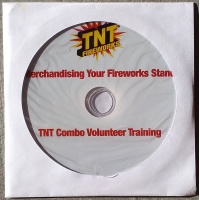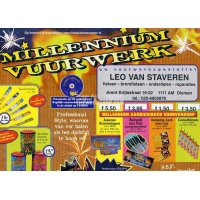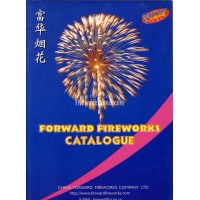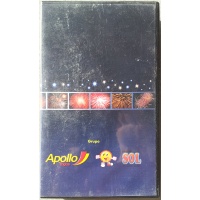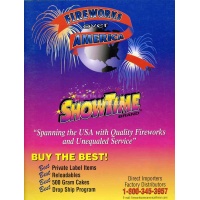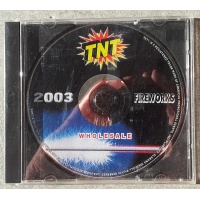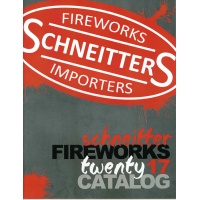The short version of this page: "Safe and Sane" usually means fireworks that do not fly or explode. Fountains, sparklers, wheels, smoke and snake items, strobes, ground spinners, novelty fireworks that do not travel, snappers and caps are usually considered "Safe and Sane" fireworks. Firecrackers, rockets, missiles, mines, shells, aerial cakes, flying spinners and roman candles are usually not considered "Safe and Sane" fireworks, although they still are perfectly legal in many states. Only certain states and cities restrict the types of fireworks sold to just "Safe and Sane" types and each place that does has its own specific definition of which fireworks are "Safe and Sane."
The long version of this page:
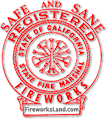 The term "Safe and Sane" was popularized in the late 1950s and 1960s to refer to a new generation of consumer fireworks. These new fireworks were thought to be safer than the ones sold in previous decades, which did include very large firecrackers and a wide variety of other devices such as rockets and aerial shells. I don't know who actually coined the term "Safe and Sane," but the meaning of the term is supposed to indicate that "Safe and Sane" fireworks were supposedly less likely to cause injury or property damage than the older fireworks were.
The term "Safe and Sane" was popularized in the late 1950s and 1960s to refer to a new generation of consumer fireworks. These new fireworks were thought to be safer than the ones sold in previous decades, which did include very large firecrackers and a wide variety of other devices such as rockets and aerial shells. I don't know who actually coined the term "Safe and Sane," but the meaning of the term is supposed to indicate that "Safe and Sane" fireworks were supposedly less likely to cause injury or property damage than the older fireworks were.
The term "Safe and Sane" is still used today to describe certain types of fireworks. The exact meaning of it varies by location. What is considered "Safe and Sane" in one city or state might not be considered "Safe and Sane" in another city or state of the U.S. Most of the time, however, when people refer to "Safe and Sane" fireworks they are generally referring to consumer fireworks which do not leave the ground, shoot projectiles into the air or explode in any way.
In general, then, "Safe and Sane" fireworks are usually fountains, sparklers, smoke balls, snakes, ground spinners, pinwheels, most novelty fireworks, and toy trick noisemakers, including some crackling ground items. In general, consumer fireworks not included in the "Safe and Sane" concept include firecrackers, rockets, aerial shells, roman candles, and any novelty firework or combination firework device that includes these types as part of the design or performance.
In my opinion, this does NOT necessarily mean that those types of fireworks are unsafe to use, and it does NOT necessarily mean that fireworks considered "Safe and Sane" are safe to use. It is certainly possible to safely use any of these types of fireworks, in either category. It could be debated endlessly as to whether fireworks considered "Safe and Sane" types are actually "safer" than other types, depending on the criteria agreed on for the debate, such as what "safe" is defined as, what "sane" is defined as, and the accuracy, completeness and integrity of the statistics brought to the debate as supporting evidence. There is no clear-cut answer on this, really, in my opinion.
These are just generalizations and the exact definition of what is considered legal or "Safe and Sane" varies by location. The state of California defines specific criteria for consumer fireworks to be considered "Safe and Sane" and therefore legal to sell in California. For example, the spray from fountains has been limited to 10 feet in height, and I have heard that the state fire marshal's office tests this by hanging a horizontal strip of crepe paper at a 10-foot height, and if any sparks from the fountain burn the paper, that fountain is rejected. I heard a rumor that that height limit may be changed to 16 feet, but as far as I know, it's still 10 feet. In California, every type of firework approved for sale as "Safe and Sane" has to be tested and approved BY NAME at the State Fire Marshal. This can lead to the possiblity that one company's product might get approved as "Safe and Sane" while another company's product might not get approved - even if their product is identical in every way except the name or something about the labeling. It's a strange way to do it, and there may be internal industry politics underlying and distorting the process, but that's basically the way it's done in California.
Other states and cities may have completely different methods of approving items for sale, which undoubtedly have their own political shenanigans going on underneath it all, sometimes resulting in one vendor's products getting approved while another vendor's don't get approved, even though they may be identical products in every respect except the name printed on the label. Some states and cities have their own specifications for what would be considered legal for sale in those locations, such as a limit on how far a ground spinner can travel from its point of origin, and other little peculiar rules that somebody thought up somewhere.
You might notice some items which bear the California "Safe and Sane" seal somewhere on the label, even if those items are not sold in California. This may happen if a factory in China or whoever designed the label hopes that the item will get approved for sale in California, and for whatever reason, that item ended up not being approved as "Safe and Sane" in California. Some items which have no chance of being approved for sale in California, such as multi-shot aerial repeaters sometimes have the California "Safe and Sane" seal printed on the label. This is either a mistake by the label designer or just a force of habit in the design phase. The appearance of the California seal on a label isn't a guarantee that the California State Fire Marshal approved that item for sale in California.
For the most part, when you hear people within the fireworks business mention "Safe and Sane" fireworks, or see that term used in a catalog or price list (such as describing a pre-packaged assortment of fireworks as containing only "Safe and Sane" items) that usually means they are referring to consuimer fireworks that stay on the ground and may shoot sparks into the air but not projectiles into the air. So a "Safe and Sane" assortment probably will contain mostly fountains and ground items, and won't contain rockets, shells, or firecrackers. Firecrackers are usually not considered part of the "Safe and Sane" group, although there are some places where they are. For example, I think the state of Hawaii allows "Safe and Sane" fireworks and firecrackers to be sold. Nebraska, according to an e-mail I received from one reader, allows only fireworks tested and approved (by name and number of shots) by the Nebraska state fire marshal. According to that e-mail, "The main criterion for approval [in Nebraska], is that nothing that goes up into the air, can come down 'hot'. This always excludes rockets, and excludes some aerial repeaters that may have pieces that come down hot, also. Nebraska does allow all 50 mg. firecrackers. And all reloadable shell kits that contain six or fewer shells, and have no multiple break shells."
Copyright © Bob Weaver. All rights reserved.

